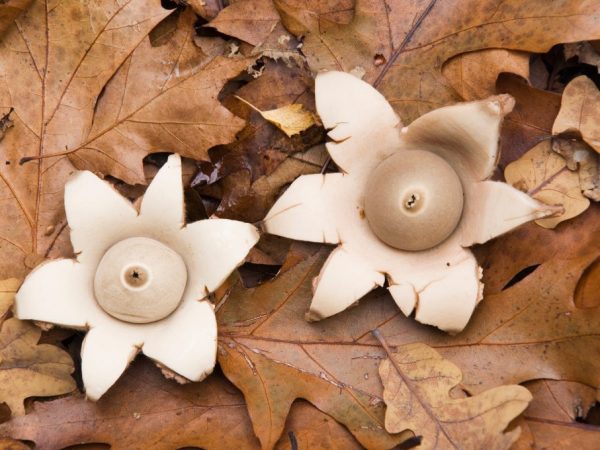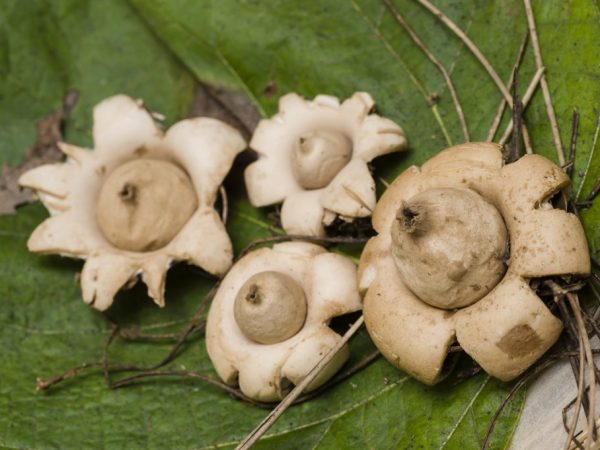Types of mushroom starfish
The starfish mushroom is a typical representative of the Starfish family and the Starfish genus. It belongs to the conditionally edible eukaryotes, which have found their application in folk medicine and partially in cooking.

Types of mushroom starfish
Appearance
The starlet mushroom also has another name - "earthen asterisk", or "geastrum" (from Latin "geo" - earth and "aster" - star).
The main body of the eukaryote is underground, where a kind of sac is initially formed. In the process of ripening, it comes to the surface, where its upper outer part bursts, the ends are wrapped. In this form, the geastrum becomes like a star with 5-10 soft spongy rays.
Inside the outer shell, there is a spore-bearing part in the form of a ball or oval. After the destruction of the outer layer, the central part of the starfish rises, thereby protruding the inner part of the fruiting body. In the center, eyelash-like protrusions are formed, covering the opening - the entrance to the spore-bearing part of the fungus, covered with a thin shell. In this position, the fruiting body fully ripens, and the rays of the outer layer of the fungus age over time, darken, sometimes disappear.
The external characteristics of a star in terms of size depend on its type. On average, the unopened upper part of the geastrum is 1-4 cm in diameter, the open star-like part is 3-15 cm.The spore-bearing part in the form of a ball usually reaches 1.2 cm in width and 1.3 cm in height.
Irina Selyutina (Biologist):
Starfish belong to the group of gasteromycetes - fungi that are characterized by the complete isolation of their fruit bodies until the basidiospores are fully ripe. These are the so-called angiocarpous fruiting bodies. Basidiospores not only form inside a completely closed fruiting body, but also separate from the basidia inside it. Therefore, this group of mushrooms is also called nutreviki. The release of basidiospores into the environment occurs when the membrane of the fruiting body is ruptured or destroyed.
Gasteromycetes are divided into groups according to the way of feeding:
- Soil saprophytes: these include starfish (geastrum), flapworms, bigheads, etc.
- Mycorrhiza formers: this group is very small; for example, scleroderma is included here.
- Saprophytes on plant debris (dead wood, fallen trees): for example, nesting.
- Parasites on the roots of higher plants: for example, parasitic rhizopogon.
Starfish mycelium is multicellular, highly branched; it is well developed and permeates the substrate in which it is immersed.
All parts of eukarite at a young age have light shades of gray, white, brown or red, again depending on the species. With aging, the color of the fruiting body darkens. The spores are brown or olive-gray.
Mushroom species
Starfish species are divided into 2 main groups. Some mushrooms are eaten at a young age, while others are not suitable for cooking. Old eukaryotes of any kind do not eat: they lose their attractiveness, become hard and tasteless, but they have other useful properties.
Inedible starfish species
Geastrooms are mostly non-edible, although they have interesting external features. They do not belong to poisonous mushrooms either. Inedible starfish are used in folk medicine. They have several types with their own characteristics:
- Starfire triple: in appearance, he has features that somewhat distinguish him from his fellows. It has a double layer of the outer shell (peridium), the upper part of which bursts into several unequal parts, and the inner part forms a bowl around the spore-bearing body. On the upper part of the spherical bag with spores, a kind of belt is formed, called a courtyard. The color of the mushroom body can be beige or light brown.
- Starfish striped: the young fruiting body is located underground and resembles a bulb in shape. As it matures, the body of the fungus spreads out long, creamy, star-shaped blades that crack and darken over time. The spore body has a small diameter, elongated shape, sits on a small thick stalk. It has a gray color, covered with a whitish bloom, the tip at the top is characterized by pronounced stripes, which is where the name of the species comes from. The main difference of the species is the location of the mycelium - on the soil surface, and as it is "accepted" - in the soil.
- Starfire topped with: has gray dull lobes of the outer shell of the mushroom body. The spore-bearing part rises on an elongated neck. But the leg is missing. The color of the ball is much darker than the star-like part of the geastrum, more like a brown tint.
- Fringed sprocket: partly shows its fruiting body from the ground. The outer shell (of the side) has a yellowish-brown tint, breaks into 5-7 lobes, which are strongly bent downward. The spore-bearing ball is gray in color and has a poorly defined courtyard. When looking from above at the organism of the fungus, one can clearly see at the edges of the blades a kind of denser fringe formed from the upper layer of the peridium.
- Small star: this species is called the smallest representative of the Geastrov family. The lobes of the upper layer of the mushroom body crack into 8-12 equal parts in the horizontal plane, then the mushroom body rises slightly. The color scheme of the star's petals is closer to beige-gray; over time, cracks appear with a lighter inner content. The spore-bearing gray ball becomes brown closer to ripening, the proboscis elongates at the apex. Interestingly, the endoperidium (the inner layer of the shell) is characterized by the presence of a kind of crystalline coating.
- Starfire black-headed: is a special kind. Its appearance in youth and maturity can be said to be strikingly different. When the mushroom body is still young, it resembles an ordinary light or slightly brownish raincoat. As it matures, the outer shell bursts into 5-8 parts, exposing the spore-bearing ball. The inner part of the star's rays and the top itself are covered with a rather thick layer of dark, often black, mature spores, which are immediately carried away by wind and rain.
- Four-bladed sprocket: during the ripening and opening of the "petals" it also raises the body above the ground. The color of the outer layer is gray-white, and the spore-bearing ball is dark gray. A special feature of the eukaryote is a pronounced flattened rim around the hole at the top of the ball - a courtyard.
Conditionally edible mushrooms

Only young mushrooms are suitable for consumption
Young mushrooms from the Geastrov family are eaten as an exotic supplement. These species are few in number. In a state of physiological maturity, mushrooms are no longer suitable for human consumption.
- Vaulted sprocket: is one of the rarest species, characterized by a flattened or spherical underground body.When the upper layer is separated, ingrown fragments of litter remain on the visible side of the blades, which create the appearance of cascades and canopies. The color of the outer part is brown, the spore-bearing ball is flattened, pale yellow, matte.
Irina Selyutina (Biologist):
The vaulted starfish is characterized by the presence in its chemical composition of a number of biologically active substances useful for the human body. For its development, this species of starfish prefers calcareous soils, i.e. soils that contain carbonates - salts of carbonic acid H2CO3.
They eat (without preliminary boiling or frying) the vaulted starlet only at very early stages of development - when in appearance its fruit body resembles a ball. But since at this time it is almost completely immersed in the soil, it is very problematic to find it.
- Schmidel's starman: the second edible member of the genus. The fruit body of this eukaryote is small, cracks and rises upward during the ripening period. The ball is located on a short stem and has large cilia around the spore hole. The entire "star" is brown, darkens with aging.
Habitat
Zvezdovik is a rare occurrence in most of Russia. It is found both in warmer regions, for example, in the Caucasus, and in the forests of the temperate zone of the European part, Eastern Siberia, as well as in Europe and in the southern states of North America. These are wild-growing eukaryotes - no one is breeding them.
The habitat of earthen stars is coniferous and mixed forests with a predominance of spruces, pines, oaks, birches, aspens, and small shrubs. Mushrooms love to settle on the banks of reservoirs in secluded places. They grow up with whole families, or "witch" circles.
By the way of feeding, these mushrooms are saprotrophs.
Light and loose sandy loam soil with an admixture of forest humus is suitable for feeding the starlet. Good drainage in the form of coniferous deposits has a positive effect on the mycelium of the fungi.
The ripening period for the spores occurs in late August and early October. In some species, in good weather, it lasts until the end of autumn.
Mushroom application
The benefits of earthen stars are closely related to their use. They do not have any toxic substances, they are similar to raincoats. They are rarely used for food: they do not have a pronounced taste or smell. Previously, such mushrooms are not boiled.
In folk medicine, the star and its controversy are more popular. They found practical applications:
- the body of a young starlet, cut into plates, replaces the plaster and dressings, because it successfully stops the blood and is able to help the speedy regeneration of the wound;
- a powder is made from mature spores, it is also added to medicinal tinctures;
- geastrum, or starfish, are rich in chemical components, therefore extracts from them are used as antiseptics and antineoplastic agents.
Conclusion
The features of the external structure of starfish mushrooms make it possible to call them perhaps one of the most original. It is difficult to find fruiting bodies in the young period of development: for the most part they hide underground. But there is a chance to collect already mature ones. These mushrooms are very rare, so they need to be protected and used wisely.



